I Tested America's Best Sofas for Months: This is Everything You Need to Know to Buy Chic Comfort Wisely
My top design-forward, high-quality picks, the best sofa brands to shop, expert advice on the chicest shapes, material choices to prioritize, and more
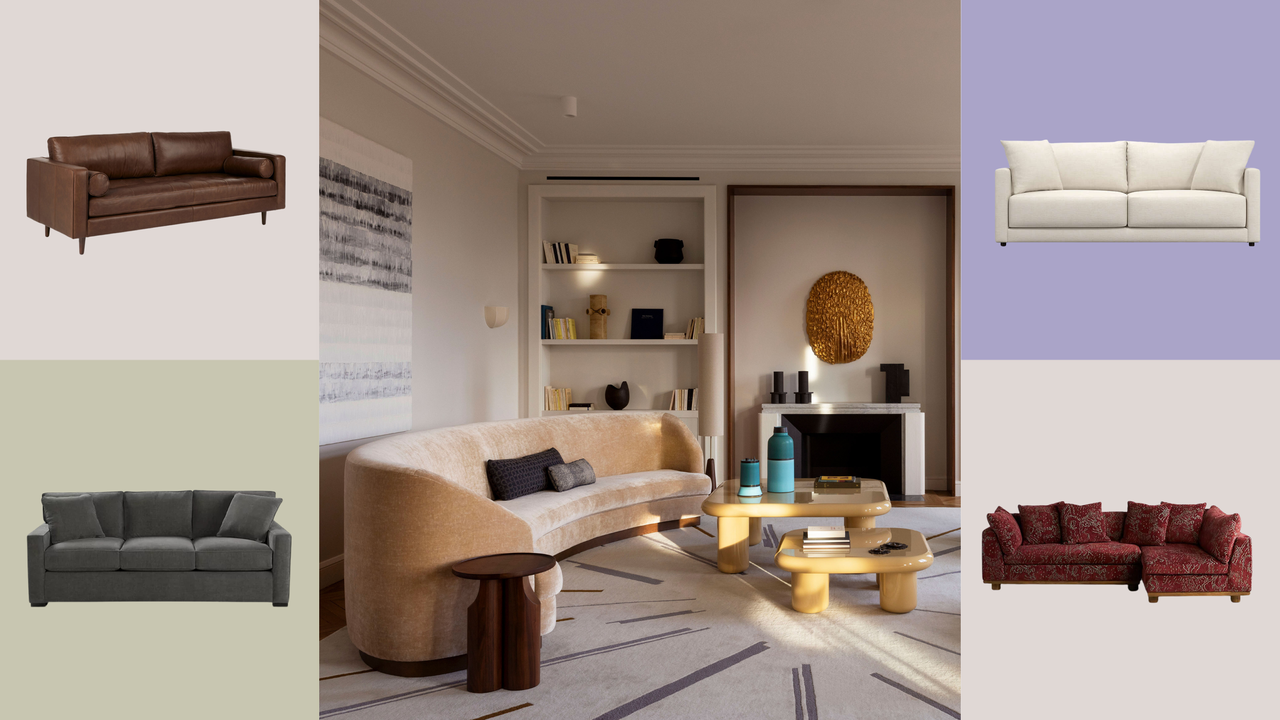
- How I picked the sofas
- My Top Product Picks
- Best Sofas: The Reviews
- How we test
- The Best Sofa Brands
- How to choose the best sofa for your lifestyle
- Sofa Types
- Sofa Styles
- Sofa Colors
- Sofa Sizing
- How to Measure a Sofa
- Upholstery
- Sofa Joinery
- Filling Choices
- Frame Durability
- How to Place the Sofa
- Sustainability and Wellness
- Flame Retardants
- Accessibility
- Warranties and Customer Service
- Delivery and Assembly
- FAQs
- Expert Sources
- Who is this for?
- How This Guide Has Changed

I've spent the past few months doing nothing but testing out the best sofas you can shop in America.
I've been in-store to comfort test dozens of couches of all shapes, sizes and constructions. I've interviewed industry experts and manufacturers for their take on how to shop quality. I've read hundreds of independent sofa reviews, as well as those of our competitors, to cross check my findings. I've canvassed hundreds of friends and colleagues for reviews of their own couches. And, I've spoken to our interiors team and interior designers for their take on the latest sofa trends.
Truth is? There's no single "best sofa", there's only the best sofa for you. But how do you make an educated choice, particularly if you're shopping online? It's all in the process: buying from a trusted brand and getting educated on what gives a sofa longevity — frame construction, upholstery, and cushion filling — is as vital as choosing a sofa for comfort, or a style, shape or color that you're going to love for at least 10 years. I've listed my top picks, but below, I'll guide you to the best-looking, most comfortable couch for you.

Having been immersed in the cross-section of high design and online shopping for over a year, I am uniquely positioned to craft Livingetc's sofa buying guide. I also just purchased a new sofa myself (the Aspen Tranquil Blue L-Shaped Sectional from Living Spaces), so was able to put all my advice below into action. To create this guide, I visited a variety of furniture stores, including Pottery Barn, IKEA and Anthropologie, and took a trip to Dallas, Texas, to tour the factory at American Leather. I read every competitor guide to ensure I left no stone unturned. What you will find here is not only a “how to choose” guide, but also a highly-curated shopping list that prioritizes aesthetics as much as quality and make. My experience crafting shopping edits and sniffing out internet trends informed this, just as it informed the color advice I gave in the “Sofa Colors" section below. There aren't many places you can get it all in one go; but at Livingetc, you can.
How I picked the sofas
TLDR: The following six sofas are ones I have personally tried and rated. I dive into specifics below, but be assured that these couches are constructed with quality materials; are extremely comfortable, regardless of sit preference; are well reviewed by others; are accessible; and, for that added Livingetc touch, stylish. I kept pricing in mind, but will concede that a few might be more than you’d care to spend. Still, if you’d like a sofa that will last a long time, that performs well even in a kid- or pet-filled household, or one that's free of chemicals, I encourage you to look past the price as much as your finances allow.
In addition to my top six, I selected two honorable mentions. These are sofas I did not get to try but feel comfortable recommending thanks to retailer reputation, research, feedback from friends and family, or a combination of all three.
My Top Product Picks
Just a note: because of the current sofa sales, the prices below are a little volatile, but I'll do my best to keep them up to date.
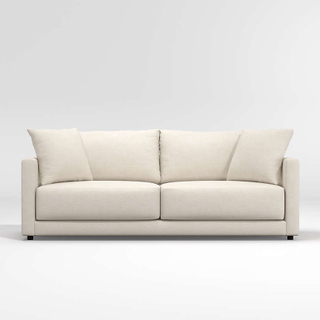
Rating: 5/5
Price: $2,399
Size: 89" W x 38" D x 26" H
Pros: Its resilient cushions are great for kids and families; boxy tailoring looks very modern; and a bench cushion is available
Cons: Issues with delivery, per some reviews
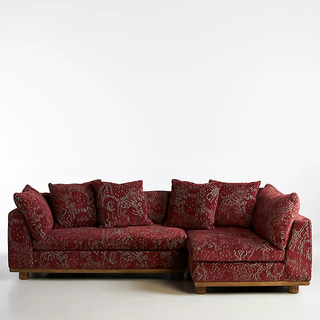
Rating: 4.5/5
Price: $4,298
Size: 32.25"H, 108.75"W, 62.75"D
Pros: Patterened fabric easily disguises stains; strong reviews
Cons: Chaise sectionals aren't the best if you plan to move
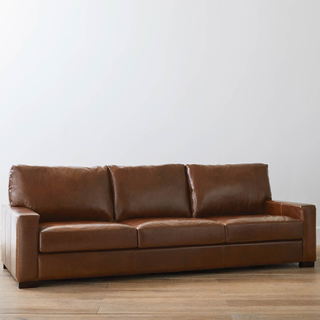
Rating: 4.5/5
Price: $2,639
Size: 85.5" w x 38.5" d x 35" h
Pros: Width/seat cushion customization is available, plenty of leather colors are available
Cons: Leather is aniline dyed, which will need to be buffed and maintained
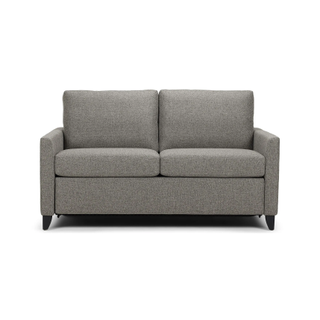
Rating: 4.5/5
Price: $4,249.95
Size: 65" x W: 40" x H: 38"
Pros: Requires no wall clearance, compact frame is great for small spaces
Cons: Have to buy through third-party retailer
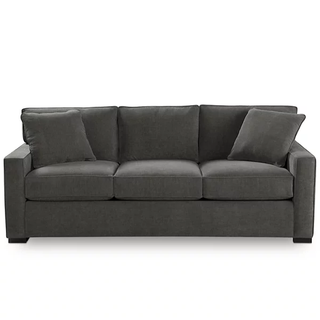
Rating: 4/5
Price: $789
Size: 86"W x 39"D x 30"H
Pros: Macy's offers frequent sales on an already great price
Cons: Glue/staple joinery, a little less stylish than preferred
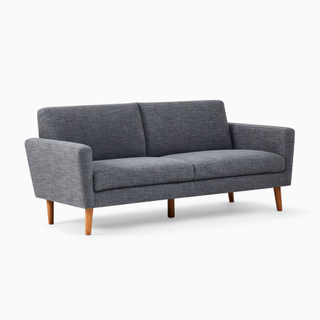
Rating: 4/5
Price: $559.20
Size: 72"w x 32"d x 30"h
Pros: Great for small spaces, tightly-woven pewter weave is good for pets, removable legs (helpful in tight entries)
Cons: Slightly wobbly back panel
Best Sofas: The Reviews

Style: Aesthetically, this loose back tuxedo looks great — plump in all the right places, tailored in the others. You can't tell in this picture, but the cushions are extremely boxy and streamlined; it's a surprising look, but a stylish one all the same. If you need something bigger, the Gather is also available in sectional sofa configurations.
Comfort: The Gather is, to me, the best sofa I sat on. The sit is what really got me. The seat cushions are innerspring wrapped in polyfoam, which means you get a soft sink mixed with a wonderful bit of bounce. You can feel the cushion move with you as you get up and down. Plushness scale is around a 4. The depth was perfect; it was great for both lounging and talking, and it took everything in me not to lay down for a nap right in the store. Plus, the cushions keep their shape well — a must if you host often or have little kids around.
Durability: It passed my bounce and shake test in-store with ease, but how does it last long-term? I looked to customer reviews, which averaged 4.6 stars out of 5 across 1,686 reviews. That kind of ratio is impressive, especially at this price point.
Pricing: Sitting in the middle of our price range, this sofa is a steal, in my opinion.

Style: This sectional Anthropologie sofa is aesthetically striking; it's not often you see red and blue paired together so expertly. To some, the red and blue fabric might be difficult to match, but in truth it's the perfect limelight-stealer in otherwise neutral or color-drenched schemes. Plus, the wood paneling on the bottom adds an additional grounding touch.
Comfort: Though not as soft as the number one choice, I wanted to curl up on the generous medium-firm seat (plushness scale 4 to 5). However, I approached the Saguaro sectional, covered in red and blue fabric, quite skeptically — surely the jacquard, where the design is woven into the weave, would prove irritating. What I found was actually the opposite. I liked that the subtle texture of the weave massaged my skin.
Durability: The dark fabric, and pattern, is a good choice for a low-maintenance couch material that easily hides stains and spills. In-store testing proved its sturdiness, no sign of creaking or wobbling. As for customer reviews, it was given a healthy 4 stars out of 5.
Pricing: This sits at the upper end of our pricing range; however, it easily sits four to five adults, which makes it good value in comparison to our number one pick, a two-seater.

Style: The silhouette of the Turner leather sofa is the perfect combination of modern and classic. It just looks good,and the leather will naturally soften and patina over time. I love the added touch of optional nailheads for additional personality.
Comfort: The top-grain leather is soft and supple without feeling cold (always my concern with leather couches). It sits at around a 4 on the plushness scale, so similar to all my choices, bar my top pick. You can choose from two different depths, depending on preference I will say that the armrests are a bit low, but that's easily overlooked when you take in the rest of it.
Durability: Its incredibly sturdily constructed. After spending an afternoon sitting on as many Pottery Barn sofas as I could, what stood out to me was its sturdiness. It's made with that quality Pottery Barn touch (engineered wood frame and corner block construction, two strong quality benchmarks). Customer reviews are not available but it's a trusted sofa brand I'd be happy to invest in.
Pricing: Compared to other leather sofas of this size and quality, this is brilliantly priced. With its durable upholstery material, it's a sofa for life, and a great investment.

Style: This neat two-seater is one of the sleekest sleeper sofas you'll ever see, perfect for a small apartment.
Comfort: Sleeper sofas aren't exactly known for being comfortable. If anything, they're just convenient. The Harris dispels that notion entirely. The pull-out bed is exceptionally comfortable. I'm serious — if every hotel in America replaced their pull-out bed with one of these, I might even prefer it to the bed; that's how comfortable it is. American Leather offers a good/better/best variety for its sleeper sofas, but the tiers do not affect comfort in my opinion; rather, it mainly pertains to the pull-out mechanism. The model shown here is the "best." I'd rate the sit as a 5 (medium firm) on the plushness scale.
Durability: This range of sleeper sofas is built to last, too. The frames boast a lifetime warranty, and your guests will practically be fighting to sleep here. I guarantee it.
Pricing: This sleeper sofa is not cheap but you're getting a great deal on comfort in my opinion. If you're maxing out your budget, I'd say you are fine to downgrade to the "good" or "better" options (the Today sleeper and the Silver sleeper, respectively) — but stick with American Leather no doubt.

Style: This classic three-seater is a go-with-anything sofa, by which I mean that if you're renting or moving fairly regularly, it's going to fit with any architecture or landlord-imposed decor. And it's popular for this reason; walking into the Macy's Furniture Gallery, I asked the salesperson: "What is your most popular model?" He promptly pointed me toward the Radley, a suite of budget-friendly sofas made exclusively for Macy's.
Comfort: I found the sit to be a nice medium-firm, around a 4 to 5 on the plushness scale.
Durability: These couches, the 86" iteration shown here, are not my favorite from a construction POV (the frame is glued and stapled) but this isn't unusual at this price point, and the sofa is well-rated with customers, at 4.2 out of 5 stars.
Pricing: The price really is quite strong. Combine that with Macy's frequent sales, and you have yourself a true wallet-friendly find. It ships fully assembled with white-glove delivery (more on that in the delivery section below).

Style: I love the look of The Oliver, a mid-century modern, loveseat style sofa. But to limit it to just that edit would be a disservice to, what I think, is an excellent basic sofa. At just 72" wide, I'd expect the Oliver to work great in compact rooms, and the stylish, tapered rubberwood legs are removable (ideal when navigating tight corners). And even better, you can easily fit three people on this at a pinch.
Comfort: I'd describe the sit as medium-firm with a bit of bounce, upright but not too upright. The seat is very firm; this is not something you will sink into; it's definitely the firmest of my picks. It's rated a 5 on the plushness scale, with 5 being the most firm.
Durability: This sofa sits at the lower end of the pricing scale so don't expect the finest construction. However, it passed my sit tests with ease, and it's from sofa-selling heavyweight West Elm, which trades on quality.
Pricing: This first caught my eye as an affordable sofa more than anything; at only $800, with this level of comfort and durability, it's a triple threat.
How we test
After three months of extensive sofa research, I've narrowed my list down to six favorites, chosen for style, comfort, durability, and pricing.
In-store visits were hugely helpful here. Of course, I couldn't test every sofa on the market at home, but I could touch and try everything in the showrooms and speak to the sales associates about the benefits and drawbacks of each model, as well as the popularity of different product lines. All this allowed me to devise a practical set of criteria to rate each couch I tried.
Read more about how we test our sofas here.
The Best Sofa Brands
Knowing where to shop for a sofa is just as important as the shopping itself; the below list, based on my personal shopping experience, industry research, and interviews with experts, should prove a great place to start. I rated each brand on a $ to $$$$ price range — $$$$ being the most expensive — and included a brief description of what each retailer is known for, plus notes on the return policy and lead time.
| Brand | Known For... | Price Range | Pros | Cons | Lead Time | Returns |
|---|---|---|---|---|---|---|
| American Leather | Its sleeper sofa, but the whole catalogue is worth shopping. | $$$-$$$$ | Excellent warranty protections | A bit harder to find online (easiest to go through a third party) but worth the search. | Retailer dependent | Retailer dependent |
| Anthropologie | Whimsical, high-design pieces with lots of customization options. Non-traditional in the best way. | $$-$$$ | Incredible variety, unique designs and construction, funky colors | Fewer customer reviews | 2-4 weeks for in-stock furniture; 8-10 weeks for custom furniture | 25% restocking fee for custom furniture; 30 days for everything else |
| Article | Modern furniture at middle-of-the-road prices. Perfect for interior design lovers who don’t want to break the bank. | $$-$$$ | Smaller inventory, with just the right amount of variety; strong customer reviews | Somewhat limited upholstery options | 1-3 weeks | 30-day return policy on all orders |
| Benchmade Modern | Quick-ship custom furniture with a modern look. | $$$ | Excellent warranty protections, exponentially faster manufacturing/delivery than competitors, most sofas ship fully assembled, free swatches | Threshold delivery (required for larger furniture) costs between $149 and $349 | Approx. 3 weeks | Full refund minus shipping fee if returned within 14 days; full refund less the shipping fee + 10% return fee if returned after 14 days but before 100 days |
| Crate & Barrel | Timeless and modern options for the whole home from a legacy furniture retailer you can trust. | $$-$$$ | Plenty of brick-and-mortar showrooms (so you can test the sofa before buying), customer reviews available | Cannot return custom pieces | 1-2 weeks for in-stock furniture, 6-8 weeks for made-to-order | 30 days for in-stock furniture, minus shipping costs; custom/made-to-order furniture is final sale |
| Design Within Reach | The place to shop for instantly recognizable design classics, like the Camaleonda Sofa or the Eames Lounger. | $$$-$$$$ | Offers lots of sales to offset high prices | Expensive prices, limited showrooms | 1-3 weeks for threshold and in-home delivery | 30 days following receipt + 10% restocking fee, save for performance seating, which must be returned in original packaging and will be charged a $59 return fee. |
| IKEA | Scandinavian design at budget prices. Minimalist, simple, and often quick-delivery. | $-$$ | Affordable price; easy assembly, versatile, functional designs | Potentially lower-quality materials, high variance in customer reviews, pieces go out of stock often | 1-2 weeks, or possibly next-day | 365 days for new and unopened products |
| Living Spaces | Massive, middle-tier retailer with thousands of fairly-priced (and accordingly made) options. | $$ | Free outdoor drop-off or $99 flat rate for all delivery items for room-of-choice delivery/assembly; same-day and next-day delivery available in certain areas | Short return window | 2-4 weeks | Within 7 days of delivery + 10% restocking fee for regular stock; no returns for custom furniture |
| Macy's | A range of furniture staples in traditional styles and a mostly neutral color palette. | $$-$$$ | Seasonal sales and closeouts can see price cuts up to 70% | Options are limited if you're looking for a more modern aesthetic | In-stock items may take a few days to a week | Varies based on reason for return. My incur a 10% restocking fee |
| Pottery Barn | An American classic. Simple, traditional investment pieces that will last a long time. | $$-$$$ | Reputation for quality construction, strong customer service, regular sales | No customer reviews on website | Non-upholstered furniture: 7-10 business days within metro areas, 2-4 weeks outside of metro areas / quick-ship upholstered: 1-5 weeks / special order upholstery: 8-10 weeks | Within 30 days, unless flagged as final sale |
| Wayfair | Perfect for shopping on a budget, so long as you’re willing to put in the work to dig through lots of product. | $-$$ | Great at replicating popular designs, plenty of customer reviews, strong high-low product mix | Varying quality | 1-7 business days, but longer for other items | Within 30 days for most items in original packaging; cannot return open box items, clearance items, and made-to-order items |
| West Elm | A little bit of everything — contemporary, traditional, and mid-century — including celebrity and brand collaborations. | $$-$$$ | Strong style, lots of showrooms for in-person testing | At times, inconsistent quality and no standard warranty | 1 week for in-stock fabrics; 1-5 weeks for “quick-ship” custom upholstery; 5+ weeks for other custom upholstery | 30 days for most items, 7 days for quick-ship upholstery items; made-to-order not eligible |
Honorable mentions
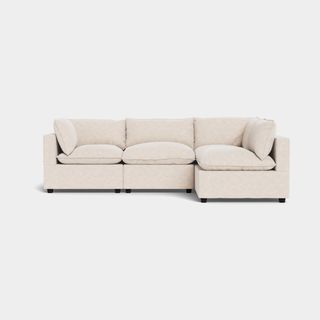
Price: $4164
Size: 120"W x 39"H x 79"D
Pros: Infinitely modular, hypoallergenic upholstery, removable seat cushions, reversible back cushions, large (depending on the size you order), lifetime warranty
Cons: Slightly difficult assembly, per some reviews; requires fluffing, per some reviews
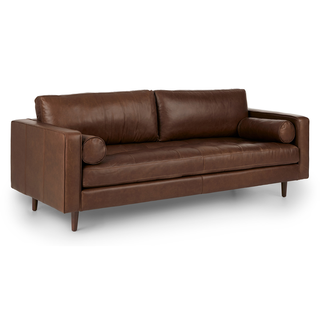
Price: $1699
Size: 34"H x 88"W x 38"D
Pros: 30-day return window, deeper-than-normal seat, leather is an easy-to-clean upholstery
Cons: Full aniline leather (needs buffing/waxing) could require more upkeep than you'd like, slouchy back cushions, per some reviews
How to choose the best sofa for your lifestyle
At the start of your sofa buying journey? Here's what to consider:
Size of Household: Do you live alone? If so, you probably don’t need a sectional or a three- to four-seater. If you have or plan to have a large family, however, something bigger and more functional is likely preferred.
“If you love hosting movie nights or gatherings, having a larger sectional will be ideal to fit more people,” suggests Anna Tatsioni, lead interior designer and architect at Decorilla Online Interior Design. “In my projects, I always keep in mind whether or not my clients have kids or pets, which will require a more durable and spacious sofa.”
Pets: If you have pets, you should be on the lookout for (1) a darker fabric to hide marks and stains; (2) removable and washable cushion covers, to ensure longevity; and (3) performance upholstery, which is typically more stain-resistant than the alternative. Alternatively, and perhaps surprisingly, a cream or white sofa with covers that can be bleached might be right for you if you have time to wash and dry when they get mucky. I’d steer clear of velvet or bouclé regardless (the latter of which might snag on your pet’s claws) and opt for something like polyester or maybe even wool (typically easier to clean) instead.
Young Kids: Children are tough on couches – and not just from a stain perspective. They’ll hang from the seats, climb over the back, and walk all over the cushions. You need a frame and seat construction that holds up. For starters, avoid nubby, textured fabrics that kids might find exciting to pick at or play with (bouclé, I’m looking at you).
Intended Use: Are you a big couch napper? If so, a single-cushion sofa might be preferred, as you won’t fall between the cracks between seats. Or, maybe you’d like a chaise sectional, where it feels much easier to stretch out.
“If you’re selecting a sofa for a media room, go deep so you can really lounge,” suggests Dan Campbell, president of BenchMade Modern, “but if it’s for more of a formal living room where you’ll be seated upright, a narrower piece is best to provide the right support.”
Climate: Mads Holm Rabjerg, Head of Product Development at Denmark’s Carl Hansen & Søn, told me that when selecting upholstery, you should factor climate into your decision. If, like Mads, you live in a part of the world or country where it's cold nine months of the year, a wool sofa might be great for you. But if you reside in sunny SoCal or the deep South, you want upholstery that feels cool to the touch. (Leather in the summer, in a house without AC? Pass!)
Moving Plans: Do you plan to move in the next three to five years? If the answer to that question is “yes,” you might prefer a couch that is (1) easy to disassemble and reassemble); (2) modular, so you can reconfigure the same couch to your new space; and (3) upholstered in a low maintenance material such as leather or microfiber (because moving trucks are dirty).
Accessibility Accommodations: It’s worth considering whether you or those sitting on the sofa might need certain accommodations either currently or over time. Is your partner 6’3” or taller? They’ll likely prefer a seat depth of 25” or more. Does your mother, who frequently visits, have a bad back? She’ll probably like something firmer and with an upright back versus a cloud sofa or low-profile option.
Sofa Types
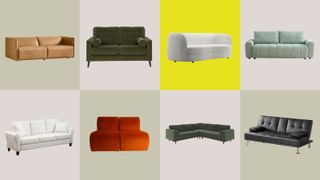
“Sofa “ and “couch” are sort of catch-all terms. If you’re looking for something specific, your language should follow suit. Here's a look at some different types of sofas; we dig into proportions more in the sofa sizing section.
Loveseat: Typically refers to a sofa meant for just two people. From a style perspective, the best loveseats often offer greatest variety and appeal.
Three-seater: A sofa meant for two to three people.
Sectional: There are three types of sectional sofas: (1) chaise sectionals, a loveseat joined on either the left or right side by a long chaise; (2) l-sectionals, a chaise and a loveseat joined at a right angle by a connecting corner seat; (3) and u-sectionals, a loveseat or a three-seater flanked on either side by two long chaises.
Sleeper sofas: There are three types of sleeper sofas: (1) futons, which involve a mattress and a bed frame stored underneath the couch cushions; (2) convertibles, where the back of the sofa folds down to form a larger sleeping area; and (3) trundles, where the extra sleeping space pulls up from underneath the sofa.
Slipcover sofas: A slipcover sofa comes with a removable, washable cover to protect the fabric underneath from stains and marks.
Outdoor sofas: Sofas for back patios and garden vignettes. Teak, wicker, and even aluminum are great materials here — stylish, versatile, and great with the elements.
Sofa Styles
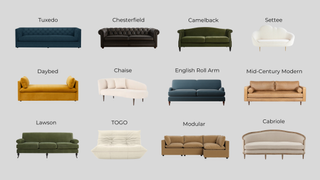
At Livingetc, looks are (nearly) everything, and your sofa's style will have a dramatic effect on your room's aesthetic, so consider carefully. For example, “if you prefer a more minimalist and less cluttered space, having a sleek and compact sofa will be the right choice," says Anna Tatsioni, lead interior designer and architect at Decorilla Online Interior Design.
Tuxedo
A tuxedo sofa is easily identifiable by arms that are the same height as the back. It gets its name from Tuxedo Park, a wealthy New York village once home to famous notables like banker J.P. Morgan and interior designer Dorothy Draper. From an aesthetic point of view, a tuxedo sofa signals elegance.
Chesterfield
Add button tufting and rolled arms to a tuxedo sofa and you have the Chesterfield, an elegant and stately option that allegedly dates back to the mid-1700s. Symbolically, Chesterfields signify wealth, luxury, and comfort, and their shape makes them great for “formal living rooms,” per Aaron Masterson, President at Local Furniture Outlet
Camelback
Popularized by 18th-century furniture maker Thomas Chippendale, the Camelback is known for an arched back with one or two humps (similar to the animal it's named after).
Settee
Smaller than a loveseat but similar in capacity, a settee is a tiny sofa meant for no more than two people … but ideally just one. You wouldn’t use a settee for lounging; rather, you might place one in your bedroom or sitting room for reading, chatting, or getting dressed. For example, Joyce Huston, lead interior designer and co-founder at Decorilla, choose a settee for a client who wanted a cozy bedroom reading nook. “It provided a comfortable spot to curl up with a book and relax,” she says.
Daybed
Daybeds are a cross between a sofa, a chaise lounge, and a bed. They typically boast a three-sided frame, with two sides acting as a headboard and a footrest, and larger, third side acting as a backrest/back panel (there are, however, plenty of stylish variations with just the headboard and the footboard). Like a chaise lounge, a daybed is great for dividing up a large room, and might even be used as a makeshift bed.
Chaise
A chaise lounge is quite similar to a daybed, but with a few key differences. For one thing, the back might not run the full length of the sofa and the arms may or may not be attached. The name comes from the French phrase chaise longue, which means “long chair.” Like daybeds, you can easily float a chaise in the center of your living room to break up vignettes. It’s a “great way to add a touch of indulgence and relaxation” to a space, Joyce tells me.
English Roll Arm
If you’re a fan of British sensibilities, an English Roll Arm could be the sofa for you. Characterized by recessed and rounded elbow-height armrests, wooden casters, and a sloping outline, the English Roll Arm gets its name from the British country manors in which it once resided. Its shape oozes with tradition; you’ve seen this style before and you’ll see it for years to come.
Mid-Century Modern
A sofa is mid-century modern not because it was made in the 1950s and 60s, but because its look is in keeping with the presiding style of that time: clean lines; wooden, often tapered legs; a rectangular frame; and seat tufting … sometimes.
Lawson
Luxury interiors brand One Kings Lane describes the Lawson as the chameleon of sofas — upholstered in the right fabric, it looks at home in any and every space. Lawsons are often skirted, with well-padded and frame-separated cushions, and are great for a nap; the sofa’s namesake, Massachusetts business Thomas W. Lawson, asked his designer to make him something extra comfortable.
Togo
The Togo began as a singular sofa designed for Ligne Roset, but its frameless body and crimped folded look have inspired thousands of copycats over the years. So while there is only one Togo, this relaxed, low-profile aesthetic is available at plenty of popular retailers, like Urban Outfitters, Pottery Barn, and more.
Modular
If, like me, you can’t make a decision to save your life, perhaps a modular sofa is the best choice for you. Modular sofas don’t have a set shape; that’s part of their appeal. Rather, they’re comprised of various modules that can be easily rearranged from one shape to another (great for open-plan living rooms, Aaron says). To keep things cohesive, however, each module is typically the same height.
Cabriole
Combine s-curved legs, an exposed wooden frame, and a curved, camel-like back and you have the Cabriole sofa, the perfect curvaceous counter to a straight-edged room. You might recognize this style of seating from 18th-century England, where it dominated in the court of Louis XV, in particular, per One Kings Lane.
Sofa Colors
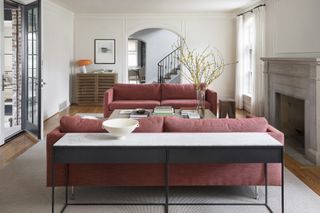
“When picking a sofa color, think of it as choosing the lead actor for your living room's blockbuster movie,” says interior designer Amanda Foster. “Consider the wall color as the backdrop, the purpose of the room as the plot, and your existing decor as the supporting cast.”
- Red: A bold color that makes a bold statement. “We love a red sofa when it isn’t the lone color in the room,” says Lauren Sweet-Schuler of Studio Sweet-Schuler. Off-white, gray, blue, and mustard yellow are other colors that go with red.
- Yellow: “Ideal for a sunroom or a playful family space in a contemporary home,” Amanda continues. “It brings cheer and optimism.”
- Green: Grounding and easy to style. “Olive green is hot right now and a beautiful sofa color for all style living rooms in a bouclé, velvet, or [a] blend. You can’t go wrong with a deep green,” Lauren muses.
- Blue: Pale blue/gray and navy are often treated as neutrals, but some designers, like NYC’s Ghislaine Viñas, are using pastel and sky blue to the same effect. Very calming (always) and very coastal (but only when styled as such).
- Purple: Purple is quite auspicious, so be sure the piece in question has “personality and can handle this bold choice,” Lauren warns. If so, it can add a touch of luxury or glam to a room, adds Amanda.
- Brown: Versatile, practical, warm, and looks great in a library or a den.
- White: Clean and crisp in look and feel. Great for minimalist rooms, beach houses, or all-around contemporary homes.
- Gray: “The ultimate neutral for modern, transitional, or industrial spaces,” per Amanda. “It's sophisticated and adaptable, fitting well in both traditional and contemporary designs." Gray is probably one of the most versatile options on this list; jazz it up with some colorful blankets and pillows that pull in other shades of the room.
- Cream: Offers a traditional versatility that’s great for rustic and farmhouse settings.
- Beige: Warm, versatile, timeless, and “suitable for both modern and eclectic spaces,” Amanda says.
- Pink: A blushy pink sofa looks playful and elegant; a bolder pink sofa is best in a shabby chic setting.
Sofa Sizing
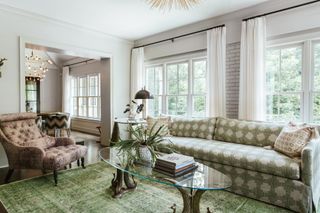
The look and feel of your sofa is only half the battle – the other half has to do with sofa dimensions. If you pick a couch that’s too big, it might overwhelm the room. But if you pick a couch that’s too small, it will look out of place.
For starters, it’s helpful to understand the average sofa size from both a sofa seat depth and length perspective; you need a solid benchmark from which to begin your search. “In general, 85” long is a great size for a sofa,” says BenchMade Modern’s Dan Campbell, “as it comfortably fits three seated people and can also fit into most spaces.” In terms of depth, “a 23” depth sofa is a good average size, but 24” or 25” is ideal for a more lounge-y, curl-up feel or for people who are a bit taller.”
Here’s what else to consider:
Room size: You don’t want your sofa to dwarf your room, and you don’t want your room to dwarf your sofa. “As a general rule of thumb, your sofa should be about two-thirds the size of your room, although that depends on a variety of factors, including how you use the room and what other furniture is in it,” Dan says. “Leave about a foot and a half as a walkway around your sofa so people can still move in between pieces of furniture.”
Your height: If you’re on the taller side, you should try for a deeper sofa seat — Dan suggests something that’s at least 24” or 25” deep. And in that case, you might like a taller back panel, as well. Crate and Barrel and Pottery Barn have plenty of deep-seat options, as does Room & Board.
Doorway size: Even if a larger sofa is best for your lifestyle or preferred for your space, it’s a nonstarter if you can’t get it through your doorway. To ensure your couch will make it from the delivery truck to your living room, first measure the size of your door frame and hallway — vertically, diagonally, and horizontally (Room & Board has a great guide for this) — as well as the size of the box, if possible (Article always includes this metric among its product specifications). If you live in an apartment, you should also measure the width of your elevator and stairwell. “Measure from the top back of the sofa to the bottom front to ensure it can fit through doorways or tight corners during delivery,” advises Mackenzie Collier of Mackenzie Collier Interiors. “This is crucial!”
Other furniture: Picture this — you’ve found your dream sofa … but it sticks out like a sore thumb next to your other furniture. And a new couch is no good if it doesn’t work with what you already own. “Ensure all furniture in a space is of a similar scale and style,” Mackenzie adds. “Mixing patterns is encouraged but should be done thoughtfully. Measure accurately before adding new furniture to ensure it will work well in the space.”
How to Measure a Sofa
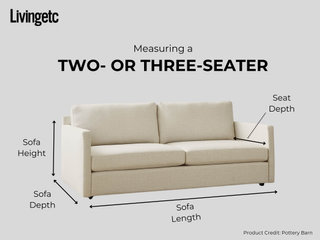
Reading product dimensions correctly is especially important when shopping online. And friends don’t let friends confuse overall depth with seat depth. Here’s the lowdown:
Overall Width: Measure from one arm of the sofa to the other. Take these measurements at the widest point. Note: length and width are often used interchangeably here.
Overall Depth: Measure from the outside edge of a seat and all the way to the back.
Diagonal Depth: Measure from the top back of the sofa to the bottom front. As Mackenzie mentions above, this is “crucial” for ensuring your couch will fit through doorways or tight corners.
Overall Height: Measure from the floor to the highest point of the sofa back.
Seat Depth: Measure from the front of the seat cushion to the back of the seat cushion. This will dictate how much actual seating space the sofa provides.
Seat Height: Measure from the floor to the top of the seat cushion.
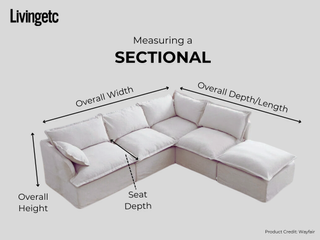
“Measure how much seating space you want (or need!) vs. the overall size of the sofa, as the width of the arm or the side pillows can minimize the actual seating area,” suggests Benchmade’s Dan Campbell. “Focus on the size of the interior seating area first, then figure out how that works with the size of sofa that fits into your room.”
Some designers suggest mapping the size of the sofa out on the floor with duct tape so you can better visualize the size; BenchMade Modern even “offers life-sized paper printouts of your custom sofa or sectional, so you can unroll that into your space prior to finalizing your order,” Dan continues. “Have your family and friends sit right on the printout,” then test if you have “enough clearance around the sofa to move in the room. This visual really helps determine if you’re selecting the proper size for both your lifestyle needs and your room’s sizing.”
General design guidelines suggest 30” to 36” between seating where possible; otherwise, try and leave about 18” to 24” on either side of the sofa for end tables, lamps, etc. “Make sure you measure your room – distance between sofa and coffee table, sofa and walls, sofa and chairs, and so on. Your furniture needs to breathe, so give it that room!” Dan says.
Most importantly: you must, must, must measure the height and width of your doorway, as well as your stairwell and elevator for apartment dwellers. Map out your path into the living room. Factor in ceiling height, banisters, and corners, too — if you suspect an obstacle, measure.
Upholstery
Especially at retailers like Crate & Barrel and Interior Define, you’re quite spoiled for choice on the upholstery front. Below, we’ll dive into the common fabrics, plus a few pros and cons of each, courtesy of Meagan Endres, category manager of upholstery at Raymour & Flanigan.
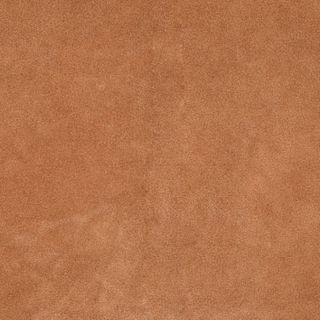
“For an upscale room, leather is a great option. The material has a luxurious feel, is durable, ages well, and is easy to clean. On the downside, leather is a more expensive option and can scratch easily if the leather is not protected.”
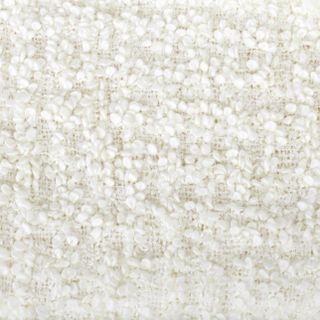
“Bouclé makes for a great accent piece. The material has a nubby feel since it is made from tiny loops in the yarn when the fabric is being produced. [It] adds dimension and texture to a space due to its chic look, but is not recommended for everyday use, nor is it kid or pet-friendly.” (And don't worry — Livingetc also has a great guide if you're wondering how to clean boucle fabric.)

“For a sofa that receives moderate use and matches a casual, relaxed aesthetic," a linen sofa is a great choice. "The natural fiber is breathable and has a light, airy feel. A few things to keep in mind about linen are that it wrinkles easily, is not very stain-resistant, and can fade when exposed to direct sunlight.”
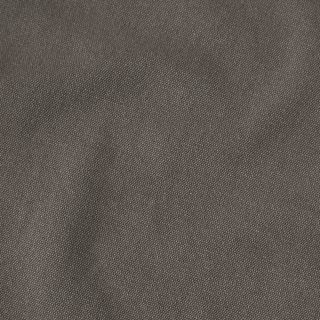
“Similar to linen, cotton is a soft and breathable fabric that offers a comfortable and casual feel. It's an affordable option that's suited for everyday use, and works well in a variety of settings. However, cotton can wrinkle easily, is prone to staining, and may not be as durable as some other materials.”
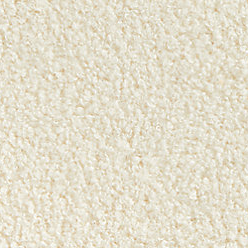
“Wool is a warm and durable material that’s naturally stain-resistant, making it a great choice for those seeking comfort and practicality. However, wool can be more expensive compared to other fabrics.”
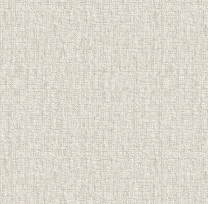
“One of the most affordable options is synthetic fibers. They are great choices for high-traffic areas or homes with kids and pets, as they hold up well to daily wear and tear. On the downside, synthetic fibers can pill over time and may not have the luxurious feel of natural materials. They’re best suited for spaces where practicality and longevity are key priorities.”
One important note — as you read product descriptions, you’ll see plenty of brands touting something called “rubs,” which is the unit of measurement for a textile durability/abrasion analysis known as the Martindale. This test determines how long a fabric can last before it shows signs of distress; things like thinning or pulling. The higher the Martindale, or “rub count” listed, the stronger the fabric.
“The Martindale test is done on upholstery fabrics to measure [their] durability and check suitability for various uses (e.g. indoor, domestic use vs. commercial use),” explains Rebecca Andrews, vice president of Category Management at Article. “The test is also known as the 'rub test', and tests for abrasion resistance. The industry standard rating is 20,000 rubs so you’ll want the upholstery you choose to exceed that.” Article subjects its fabrics to up to 50,000 rubs.
Sofa Joinery
As its name suggests, joinery connects and reinforces the joints of your sofa, providing structural support that contributes to the longevity of the frame. There are a few different processes here, but Meagan recommends sticking to mortise-and-tenon or dowel joints for “optimal sofa durability.” Joints secured with staples or nails “should be avoided” as they “weaken over time.” This information should be available on a retailer’s website or in the product specifications/tear sheet.
In our conversation, Mads at Carl Hansen & Søn spoke highly of dovetail joints, as well. These joints are “more difficult to do,” he tells me, as they require “very sharp tolerances, and you have to assemble it a certain way.” If the manufacturer or craftsman took the time to do this, “they generally know what they’re doing,” he continues. “It’s a quality stamp, in my opinion [...].”
Filling Choices
“Different fills cater to different needs, affecting how much a person sinks into the sofa or how firm the support feels,” per Lemieux et Cie’s Christiane. Here’s a quick look at the common varieties:
High-resiliency / high-density foam: High-resiliency and high-density foam are two common foam options. High resiliency is the best, per Ameer at SOOT. “It generally applies to foam that weighs 2.5 points per square foot or more. And that’s foam that’s going to last a while.” Broadly speaking, foam is quite durable and supportive without too much sink; it also requires less maintenance than something like down and feather (good for families!). If you’re craving a super plush feel, though, foam isn’t the move for you.
Down fill/Feather fill: Down/feather fill is great for “deeper couches,” Christiane says, “as it allows for a luxurious, plush feel, letting users sink into deep comfort.” Down or feather-filled cushions are also “softer and more malleable, enhancing the lounging experience typical in deeper sofas.” That said, such seating is usually more expensive and requires a bit more maintenance (re: frequent fluffing and plumping) so it doesn’t lose shape.
Hybrid: Hybrid fillings offer a mix of foam, fibers, and feathers for a balanced and well-rounded seating experience. For instance, something like a foam core covered in a down wrap boasts the “resilience and support of foam alongside the soft, enveloping comfort of down,” Christiane explains
Fiber: A fiber filling is a synthetic filling made from materials like polyester or polypropylene. It’s typically less expensive and meant to imitate the comfort and feel of more natural materials, but it’s not as plush as the real thing.
Memory foam: A memory foam fill contours to your body and provides “excellent pressure relief,” per Christiane, a great choice for long periods of sitting or lying down.
The foam is almost always chosen for you, so make sure to read the product specs before buying — you will be able to determine what type of foam or filling the product is using. As another helpful resource, I’d recommend this guide from furniture brand Castlery.
Frame Durability
Think of the frame as the bones of your sofa. If the bones are strong, so is your purchase. Where possible, look for solid hardwood (ash, oak, beech, and walnut are good options) or engineered wood/plywood; this information should be readily available in the product description. Some experts or articles will tell you that the wood should be kiln-dried, but Carl Hansen & Son’s Mads Holm Rabjerg says that’s not necessarily a make-or-break mark of quality. All that matters, he says, is that the wood reaches the correct humidity before construction begins, whether that’s via kiln or air.
A metal or steel frame is not a bad choice, per se — they are typically strong and durable, adds Meagan from Raymour & Flanigan — but they “can be heavy and may not offer the same level of comfort as wooden frames.”
Avoid particleboard where you can; it’s a common material, but “the density is low and can easily break when pressure is applied,” per Rebecca Andrews. Ameer Radwan, owner of LA-based upholstery studio SOOT Design Studio, also suggests you avoid a pine frame, if you see it. “[Pine frames] aren't necessarily going to break, but it's going to be a situation where you can sort of just grab the arm and shake it multiple inches,” he tells me. “It's going to feel lighter and it's going to feel jankier every time you experience it.”
How to Place the Sofa
Wondering how to get the best living room seating plan? For starters, Benchmade’s Dan Campbell recommends “centering your sofa on elements in the room — such as a fireplace, TV, or a window — and then build from there. This will give the room symmetry.” Consider how you use the space; if you’re a big Netflix fan, place your sofa in front of the TV. But if you’re more of an eat-and-drink-on-the-couch-while-you-read kind of girl, setting up shop where there’s room for an end table and a lamp might be more prudent.
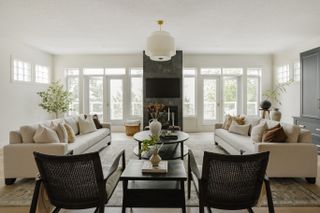
Generally and if your room allows, you should avoid pushing your sofa against the wall. But if you must, float it out ever so slightly for a room-largening optical illusion. You should also avoid placing your sofa in front of a window — you don’t want to block any natural light! — but you could get away with it if you (1) use a sofa with a shorter back panel and (2) pull it out from the wall. Be mindful of heating or air vents, as well. You wouldn't want your sofa so close it presents a fire hazard or blocks airflow.
Sustainability and Wellness
Broadly speaking, the most sustainable sofa you can buy is one you will keep. If you’re looking for a rule of thumb to follow without getting into the nitty gritty of natural fabrics and delivery options, that is it: invest in a well-made, high-quality piece of furniture you can use for years. This might mean you look for cushions or cushion covers that are reversible or replaceable; it might mean you try a modular sectional that you can easily reconfigure no matter the room; or it might mean you opt for a performance fabric with a higher Martindale so it will last longer against kids and guests.
Mads suggests prospective buyers also consider how their sofa could be repaired if it breaks. Are replacement parts available? Or is a busted frame a one-way ticket to the dumpster? If you can fix the piece, that’s probably the more sustainable option.
At Retroloop, an eco-conscious and longevity-minded brand from entrepreneur Amanda Beare, modularity is the secret sauce … and the principle around which the rest of the project revolves. “We really were focused on creating a modular sofa, because we know that life happens, and in the event that some piece of your sofa gets damaged, we don't want the whole thing just to be thrown out,” she tells me in an interview. “So that was kind of the first piece of thinking about manufacturing — how do you design something that is timeless in its design, it'll withstand the test of time, and it's designed so that if something happens to it, the whole thing doesn't need to be disposed of?” The answer: modular components.
Even better (and something you yourself can look out for when shopping), Retroloop uses what’s called “flat-pack shipping,” where the different components are packaged and shipped in separate, relatively flat boxes. Such an arrangement, which is “a lot less bulky and cumbersome than just delivering furniture on pallets,” is much easier to deliver, as you can fit more orders on one truck, and has a “lower carbon footprint than shipping on pallets.”
From an upholstery standpoint, Amanda recommends looking for OEKO-TEX® and UL GREENGUARD-certified fabrics if both wellness and sustainability are on your mind. Both offer various certifications re: product safety and sustainability as they pertain to textile manufacturing. For example, an OEKO-TEX® Standard 100 fabric is certified harmless to human health, and every "thread, button, and accessory have been tested against a list of over 1,000 harmful substances," per the website. The GREENGUARD certification from product testing company UL Solutions is similar, although the label goes beyond just textiles and instead speaks to the product as a whole.
“We look at performance, not just from what you can see, [but] we also look at it from what is off-gassed from that product in your home,” Brayden West, Global Senior Product/Service Specialist at UL Solutions, tells me. Specifically, the company is looking at VOCs, or volatile organic compounds. “We're screening for over 12,000 different volatile organic compounds and chemicals,” he continues. “And then we have a strict limitation on the total off-gassing that comes from a product, as well as individual levels.”
If you’re looking for more information or to check a specific product against the GREENGUARD criteria, try UL Solutions’ extensive public sustainability database known as SPOT. “It’s essentially a point of truth for consumers,” Brayden says. Of course, it includes products and brands with that GREENGUARD certification, but “we have everything from recycled content programs, recyclability, [and] zero waste to landfill,” too.
An important disclaimer: While OEKO-TEX and GREENGUARD certifications can offer peace of mind from a sustainability and health standpoint (and you’ll likely encounter others in your search, like “FSC-Certified” wood and “CertiPUR-US” foams), it’s important to remember that these are voluntary certifications; they only apply because the company or manufacturer behind the product could pay for it and found it valuable. It doesn’t necessarily mean that one couch is better than the other; rather, it just means that a third party was involved in vetting the manufacturer/company’s sustainability and health claims.
Flame Retardants
Now, you’ve probably also seen or heard all the hullabaloo about couches containing potentially harmful flame retardants. But the good news is that most couches no longer use them, thanks to a labeling law passed in California. So while OEKO-TEX and GREENGUARD certifications are helpful benchmarks from both a health and sustainability perspective, you can otherwise check a sofa for flame retardants by reading the label, on which manufacturers are required to denote whether the product contains such chemicals. (Since California is such a large market, the majority of manufacturers and brands comply with the state’s regulations.) If your product does contain flame retardants, well, it’s not cause for panic. Honor your comfort and use your discretion, of course, but such chemicals “are usually present in your couch at such low levels that they’re not going to turn you into a mutant ninja turtle,” writes Alex Back, CEO and founder of Couch.com + founder of Apt2B.
For more on chemicals, off-gassing, and sofa-related frame retardants, I highly recommend the aforementioned write-up from Couch.com.
Accessibility
If you have leg, knee, or back problems and want to get up and down from your sofa comfortably, look for a couch with a firm sit and a seat depth around 20”. You’ll also want something with an upright back and armrests, both of which provide added support getting up and down.
For lounging, a reclining sofa might work great from an accessibility standpoint; just be sure you choose one with a power recline (easier on your body and requires less muscle to maneuver). Moreover, you might want something with built-in USB charging (so you don’t have to get up and down to plug in your phone), a fold-down table for food and drinks, and/or side storage for your reading material.
Warranties and Customer Service
“When buying from a reputable brand, especially legacy manufacturers rather than third-party sellers, you're more likely to have a positive customer experience. A higher price can mean better customer service and product support. Negative reviews can offer insight not only into the product but also the company, particularly how they handle customer concerns. Look for reviews where company representatives respond to issues, as this reflects customer care.
Rebecca Andrews from Article suggests checking the manufacturer’s warranty for coverage of "defects in materials and workmanship on the sofa for at least one year." This protects against defects arising from normal use, but doesn’t cover damage caused by the owner (like stains or rips). Most retailers provide at least a one-year warranty.
For extra peace of mind, an extended warranty (covering 3-5 years) can protect against accidental damage like spills or tears. Alex Back from Couch.com recommends selecting a warranty that covers the frame, cushions, and upholstery, along with repair or replacement options.
For a detailed comparison of warranties across brands, Couch.com offers a helpful list.”
Delivery and Assembly
Many retailers offer a sliding scale of delivery and sometimes assembly options. Here is a quick look at what the most common options entail:
Curbside Delivery: Your couch is delivered outside your home, very likely on your driveway or curb.
Front Door Delivery: Your couch is delivered right to your front door, but typically not brought inside or assembled.
Threshold Delivery: The delivery team will bring your couch through your front door and set it down. They will not move it past that point.
Room of Choice Delivery: The delivery team will bring the couch to your chosen room; this may include stairs, depending on the price of the service. Assembly is not included.
White Glove: The Ritz-Carlton of delivery services. The delivery team will bring the couch inside, set it down in your room of choice, assemble it, and then remove and dispose of the packaging.
For a relatively up-to-date list of the delivery options at each major retailer, this chart is extremely helpful.
FAQs
Expand this section
How much should I spend on a sofa?
Let’s address the elephant in the room — sofas are expensive. Yes, there are more affordable couches out there, too, but in spending less, you run the risk of buying a poorly made product. So after taking into account what I’ve learned from experts and the products I’ve tried, I would suggest spending no less than $800 on a new couch. Still a pretty penny, sure, but not enough to break the bank entirely.
In an ideal world, you could spend $1,500 to $2,500 — even more than that — with the understanding that your new loveseat will consequently last 10+ years (very good for a couch). But I know that’s not possible for everyone. $800 is therefore a good middle ground; most mass market retailers — your Pottery Barns, your Crate and Barrels, and your West Elms, all of which you can trust — offer a more budget-friendly option within this range, one constructed with each retailer’s signature quality and customer experience. Wayfair is another great option here; while there are some no-flys hidden amongst its ranks, there are plenty of affordable and well-constructed pieces for sale, as well. (You can find some of our favorite Wayfair sofas in our dedicated edit.)
If you want a well-made sofa but price is still a big concern, I'd recommend waiting for a holiday sale to splurge. Especially around Black Friday, most if not all retailers will offer furniture sales — perhaps their only markdowns of the year. If you time it right, you could snag a $1500 couch for $900, or a $900 couch for $500.
Expand this section
How long should a quality couch last?
How long a couch should last all depends on wear and tear, but a nice couch should last somewhere around 10 years. That's why it's worth it to invest in something quality; sure, $1,500 seems like a lot at once, but it's nothing spread across a decade. If you buy one uncomfortable $300 couch every year for three years, it would have already been worth it to buy the nicer option once.
But don't forget — proper maintenance also plays a factor. Be sure to clean stains as they occur, and vacuum and plump the cushions as needed. A well-made frame can certainly withstand some over-active toddlers, but try to keep jumping to a minimum. And don't be afraid to protect your purchase with a third-party warranty if that would provide some peace of mind; especially with purchases over $3,000, I think this could be a good way to go.
Expand this section
Should I sit on a couch before buying it?
Generally speaking, yes, I would recommend sitting on a sofa before buying it — this will ensure you actually like the pitch of the seat, the feel of the upholstery, and the give of the cushions. That said, not every retailer has a showroom, and those that do might not have one near you. So while you should definitely do your best to spend some time with the product before buying, know that plenty of people purchase a couch sight unseen, especially in today's day and age.
If you can't sit on the sofa, I would first recommend polling your network. Do you or your friends know anyone who has tried this brand or purchased this model? See what info you can gather from trusted sources. There's nothing better than a first-person review. If you strike out here, turn to the internet. If you find a model you like, check that it has lots of positive customer reviews; I always like to sort "newest" to "oldest" to get a more accurate picture of the product now and what recent consumers had to say. If there are no customer reviews (which, depending on the retailer, might be a red flag in and of itself), do a quick Google for editorial reviews of that model in particular. Use those as your guide instead.
But if all else fails, just make sure you buy from a brand with a generous return policy... or at least a return policy you understand. Some retailers allow for 30 days; others a mere seven. If you have a game plan and know what you have to do (and also don't mind paying a restocking and/or return shipping fee), you could always send the couch back if needed. I wouldn't buy planning on doing that, but it's a nice fail-safe should you need.
Expert Sources
In addition to standard conversations with interior designers, I also conducted interviews with multiple sofa experts to better understand the couch buying and manufacturing process. I also visited my local Pottery Barn, Anthropologie outlet, West Elm, Macy's Furniture Outlet, Burrow, Joybird, Ashley Home, Crate & Barrel, and IKEA, and flew to Dallas, Texas, to spend a day touring the American Leather sofa factory.
See a full list of sources below:
- Ameer Radwan, owner of SOOT Design Studio
- Rebecca Andrews, vice president of category management at Article
- Taylar Hoffman, product director at American Leather
- Dan Campbell, president of Benchmade Modern
- Meagan Endres, category manager of upholstery at Raymour & Flanigan
- Mads Holm Rabjerg, head of product development at Carl Hansen & Søn
- Amanda Beare, founder and owner of Retroloop, a sustainable furniture company
- Christiane Lemieux, furniture designer and owner of luxury furniture brand Lemieux et Cie
- Brayden West, global senior product/service specialist at UL Solutions Retail & Consumer Product
- Aaron Masterson, president at Local Furniture Outlet
- Traci Reeves, senior director of merchandising of Grandin Road
- Anna Tatsioni, lead interior designer and architect at Decorilla Online Interior Design
- Amanda Foster, interior designer and founder of Foster Decor Consulting
- Lauren Sweet-Schuler, interior designer and founder of Studio Sweet-Schuler
- Mackenzie Collier, founder of Mackenzie Collier Interiors
- Andrea Lackie, founder of Andrea Lackie Design
- Carolyn Cerminara, founder and principal designer at Cerminara Design
Who is this for?
This guide only includes the tried-and-trusted brands I've worked with, shopped, and tested over the past few years, and only mentions specific sofas if I have testing evidence from trusted friends and family, my own first-hand experience, or scouted excellent first-person reviews online. Buying a sofa is an incredibly personal choice, with thousands of combinations of styles, shapes, colors, finishes, and sizes to choose from. But in reading this guide, you'll take my buying mastery (and soon yours) into account. We'll be shopping only the best sofa brands — and only the sofas I can hand-on-heart recommend.
How This Guide Has Changed
If you’re an avid Livingetc reader, you might have noticed that this specific page looks quite different than before. What used to be a list of our favorite sofas, selected for aesthetics and from some of our most trusted couch brands, is now a much deeper consumer report, one I hope improves the already-stressful process of online sofa buying. Indeed, instead of reading 15-20 different articles about sofa height and cushion fill, among other dry topics, everything you need to find your perfect couch is right here — and served to you through an omnipresent lens of aesthetics (because this wouldn’t be Livingetc if it weren’t).
This piece was first updated at the start of October. It was then I added in information regarding the best sofa brands, upholstery, frame durability, and more. In this update, I've expanded upon the previously provided retailer information, and shared my top product recommendations for the curious shopper, among other additions.
In November, I added a table of brands to make reading that easier. I've also added more on sofa colors, styles and shapes, including illustrations to show the breadth of what's on offer.
Be The First To Know
The Livingetc newsletter is your shortcut to the now and the next in home design. Subscribe today to receive a stunning free 200-page book of the best homes from around the world.

Brigid Kennedy is a freelance writer and former style editor for Livingetc.com, where she scoured the internet for the best and most stylish deals on home decor and more. She also served as the website's in-house sofa expert, completely revamping and reworking Livingetc's expansive sofa buying guide by interviewing a total of 17 interior designers and sofa experts at top brands like Article and Benchmade Modern; sitting on upwards of 50 sofas across both Pittsburgh and New York City; extensively polling her friends and family for their own sofa-buying anecdotes and product recommendations; and traveling to Dallas, Texas, to tour the floor of a couch factory. In total, she estimates she has spent 40+ hours (and counting!) reading, writing, and talking about couches with accredited sofa connoisseurs o then pass that knowledge on to you. She describes her personal design style as colorful and clean, and in her free time enjoys reading, watching movies, and curating impossibly niche playlists on Spotify. She recently relocated from Manhattan to Pittsburgh, Pennsylvania, where she's decorating and DIYing a new home downtown.
-
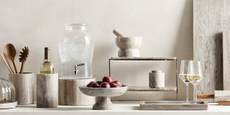 Your Kitchenware Could Use Some Italian Elegance — Get the Look With Crate & Barrel's Tuscan Kitchen Collection
Your Kitchenware Could Use Some Italian Elegance — Get the Look With Crate & Barrel's Tuscan Kitchen CollectionComplete with products all made from sleek, beige marble, this collection captures the rustic charm of Tuscany through practical kitchenware that's simply stunning
By Devin Toolen Published
-
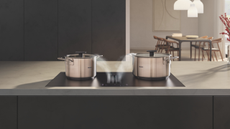 Miele Just Made One Tiny Tweak to Its Pans That Makes So Much Sense (and Solves a Big Cooking Bugbear)
Miele Just Made One Tiny Tweak to Its Pans That Makes So Much Sense (and Solves a Big Cooking Bugbear)These new pots are perfect for open-plan kitchens and here's why
By Maya Glantz Published
-
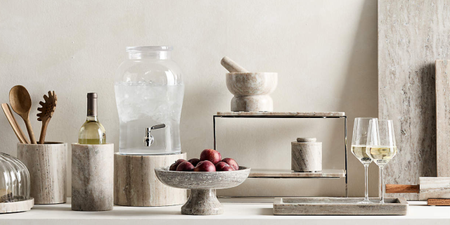 Your Kitchenware Could Use Some Italian Elegance — Get the Look With Crate & Barrel's Tuscan Kitchen Collection
Your Kitchenware Could Use Some Italian Elegance — Get the Look With Crate & Barrel's Tuscan Kitchen CollectionComplete with products all made from sleek, beige marble, this collection captures the rustic charm of Tuscany through practical kitchenware that's simply stunning
By Devin Toolen Published
-
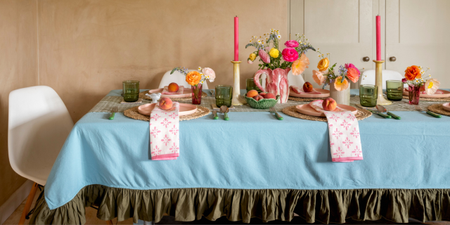 Decorative Table Linens Might Be The Key To Making Your Tablescape Come to Life — A Designer Weighs In
Decorative Table Linens Might Be The Key To Making Your Tablescape Come to Life — A Designer Weighs InWhy settle for bland tablecloths, placemats, and napkins? From now on, we're styling our tables with exciting linens in all sorts of decorative colors and patterns
By Devin Toolen Published
-
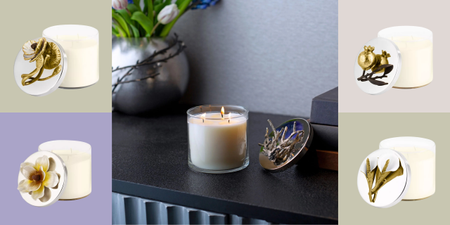 These Michael Aram Candles Are Like a Work of Art — I Spent 45 Minutes in Store Finding the Best Fragrances
These Michael Aram Candles Are Like a Work of Art — I Spent 45 Minutes in Store Finding the Best FragrancesAside from a captivating olfactory experience, Michael Aram candles offer a tasteful addition to your home decor through their decorative lids
By Devin Toolen Published
-
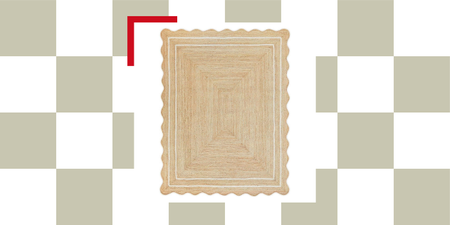 Scalloped Jute Rugs Are Having a Moment — I've Just Found the Best One Right Now With $50 Off
Scalloped Jute Rugs Are Having a Moment — I've Just Found the Best One Right Now With $50 OffThis Walmart rug does scallop trim so well. And combined with jute fabric? Consider this the summer rug of my dreams
By Devin Toolen Published
-
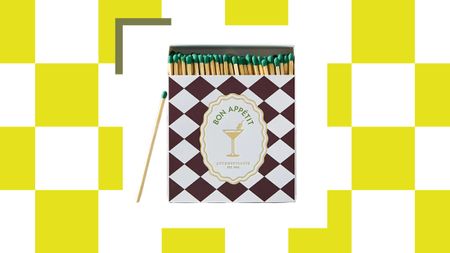 Drop the Lighter — This $15 Matchbox Is the Chic Home Accessory You’ll Want to Start Collecting
Drop the Lighter — This $15 Matchbox Is the Chic Home Accessory You’ll Want to Start CollectingMeet the conversation-starting, candle-lighting, universal gift you’ll want by the dozen
By Julia Demer Published
-
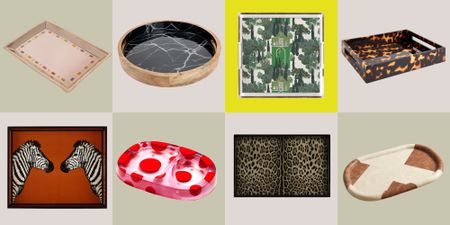 Stop Hiding Your Clutter — These 9 Patterned Trays Will Instantly Elevate the Mess
Stop Hiding Your Clutter — These 9 Patterned Trays Will Instantly Elevate the MessGive odds and ends a new, artistic address
By Julia Demer Published
-
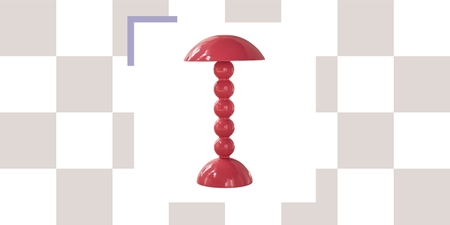 Portable Lamps Are Getting Better and Better, But This Anthro One Might Be My Favorite Yet
Portable Lamps Are Getting Better and Better, But This Anthro One Might Be My Favorite YetWith its distinctive shape, glossy finish, and practical portability, this lamp is bound to enhance your home decor in more ways than one
By Devin Toolen Published
-
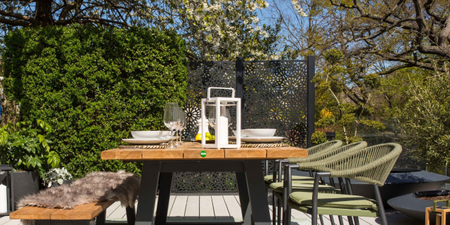 These Privacy Screens From Wayfair Will Turn Your Backyard Into An Outdoor Oasis — And Keep Nosy Neighbors Away
These Privacy Screens From Wayfair Will Turn Your Backyard Into An Outdoor Oasis — And Keep Nosy Neighbors AwayPrivacy screens are a necessary feature of backyard design, and Wayfair has some of the finest options. Here, outdoor design experts explain their importance
By Devin Toolen Published